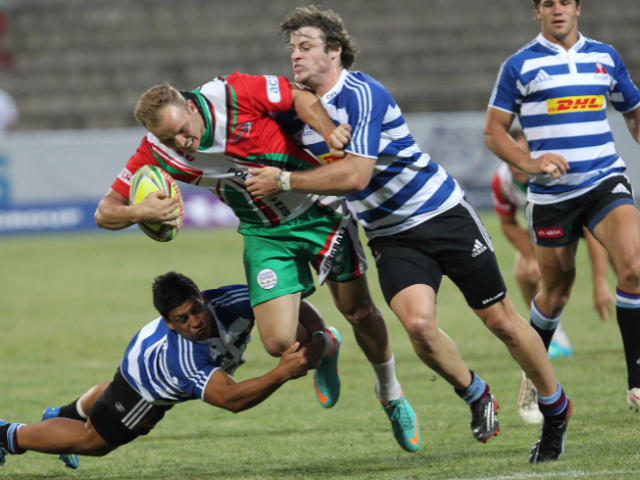Rugby sevens is all about speed, agility, and power.
Speed is your greatest asset, whether running past defenders or reacting to a sudden play.
Let’s break down some essential drills and techniques that will help you zip past defenders like rugby legends Waisale Serevi and Dan Norton.
Warm-Up
It’s crucial to prepare your body before it begins intense drills. A good warm-up can prevent injuries and boost your performance.
- Start with light jogging: This gets your blood flowing.
- Dynamic stretches: Do high knees, butt kicks, and lateral shuffles to mimic movements you’ll do you’ll game.
- Gradually increase intensity: Increase your workout by slowly ramping up the effort.
Sprint Technique: Master the Basics
Even the fastest runners can improve their technique. Focus on key elements of your sprinting form to maximize your speed:
- Drive your arms: Pumping your arms properly helps propel you forward.
- Push off the balls of your feet: Avoid landing flat-footed to maintain speed.
- Keep your head steady: It reduces wasted movement and helps you stay in control.
Agility and Footwork: Dance Around Defenders

Sevens rugby is all about quick changes in direction. The better your footwork, the easier it will be to dodge defenders:
- Ladder drills: Set up agility ladders to improve foot speed and coordination.
- Cone drills: Practice cutting, sidestepping, and accelerating out of sharp turns.
- Focus on reaction time: Imagine weaving through defenders like Dan Norton.
Explosive Power: Build That Acceleration
It would help if you exploded off the mark to excel in rugby sevens truly. Plyometric exercises are perfect for building that quick burst of speed:
- Box jumps: Jump onto a box to work on your leg power.
- Bounding: Leap forward in giant strides to improve distance and power.
- Depth jumps: Jump from a raised surface and rebound into the air to build explosive strength.
High-Intensity Interval Training (HIIT): Simulate Game Intensity
Sevens games are fast-paced with constant action; your fitness must match that pace. High-Intensity Interval Training (HIIT) mirrors the game’s degree
- 30-second sprints: Go all-out for 30 seconds, then rest for 30 seconds.
- Repeat for 10-15 minutes: This builds your ability to perform at peak speed repeatedly.
Ball-in-Hand Drills: Speed Meets Skill

It’s not It’s about running fast; you need to handle the ball at top speed, too:
- Zigzag courses: Set up a course with cones and sprint through while passing the ball to simulate real-game scenarios.
- Quick offloads: Practice throwing the ball to a teammate while running full speed, just like the top teams in the HSBC World Rugby Sevens Series.
Plyometric Acceleration
Your first few steps are critical in sevens. Plyometric drills can help you generate power quickly:
- Split squat jumps: Explosively jump from a divided stance to improve leg power.
- Single-leg hops: Focus on driving forward with each hop to enhance your acceleration.
Recovery and Injury Prevention
Speed training can take a toll on your body, so recovery is critical:
- Cool down properly: After training, do light jogging and static stretching.
- Focus on recovery: Use foam rollers and compression gear to help your muscles recover faster.
- Rest days: Remember to rest! Don’t Even the pros need time to recover.
Putting It All Together: A Weekly Speed-Boosting Program
To get faster, you need a consistent routine. Here’s a weekly plan to mix these drills into your training:
- Day 1: Sprint technique and agility drills
- Day 2: Plyometric power and ball-handling drills
- Day 3: HIIT and recovery
- Day 4: Acceleration drills and agility work
- Day 5: Rest and recovery
Consistency is key—stick with the plan, and you’ll see love.
Advanced Speed Techniques for Sevens Rugby

Now that you’ve got the basics down with some advanced strategies for improving your speed:
Reactive Agility Drills
In sevens, reacting quickly to sudden changes on the field is essential. Set up drills where a teammate signals your next move at the last second to improve your reaction time.
Resisted Sprints
Adding resistance with bands or sleds challenges your muscles and builds explosive power. Once the resistance is removed, you’ll notice your speed increase.
Overspeed Training
Train your body to run faster with slight downhill sprints or assisted runs with resistance bands to push your limits.
Cognitive Speed Drills
Train your brain by adding decision-making elements to your sprints. For example, a coach calls out a direction at the last moment, forcing you to react quickly.
Lateral Movement Mastery
Sidestepping and changing direction are as crucial as straight-line speed. Practice lateral shuffles and crossover steps to improve your ability to dodge defenders.
Conclusion
To succeed in rugby sevens, you need more than just raw speed—agility, endurance, and mental sharpness.
By incorporating these drills and techniques into your regular training, you’ll be better, more agile, and better prepared for the demands of the game.
Stick with your training, and soon you’ll be fouling past defenders at top tournaments like the HSBC World Rugby Sevens Series.
Speed is your biggest asset in sevens, and with dedication, you’ll be the player your team relies on to break through the opposition.
Keep pushing yourself, and watch your game improve dramatically!
Don’t miss out! Check out our latest published articles for more in-depth rugby insights and tips.